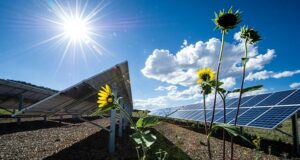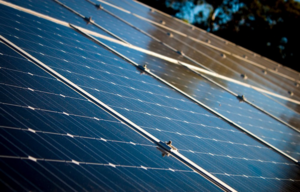Battery storage acts as one of the important aspects of a solar power system mainly because it helps store the excess energy and utilize it later when needed.
Generating power only when sunlight is available is one very important characteristic of a PV (photovoltaic) system. Battery storage is crucial for systems that use photovoltaics as the sole energy source and here a PV system with battery storage comes in handy.

Source: https://www.nrel.gov/research/assets/images/re-photovoltaics-26962.jpg
A photovoltaic system with battery storage is a reasonable investment. It plays a vital role in environmental protection and sustainability and uses renewable energy to generate electricity and power up electric devices.
A PV system with battery storage is a perfect option for those seeking a sustainable energy source. Before installing it at home, let us explore it further.
Functioning Of A PV System With Battery Storage
A PV system with battery storage generates sufficient energy during the day. This energy is utilized to meet your household’s needs.
Some days, the system produces excess energy. In a conventional setup, the excess electricity is sent back to the grid, helping you to reduce your electricity bills.
In the case of an energy storage system, the excess energy is stored in batteries. These batteries store the excess electricity generated during the day, making it available for use during periods when the solar panels can’t produce enough energy. Like during cloudy days or at night.
Implementing this solution reduces the dependency on the grid. It can also cut your electricity bill, depending on the size of the battery.
Battery storage systems are particularly crucial for homes that operate without the electrical grid. This includes places like remote buildings or mountain lodges that solely depend on renewable energy.
PV system with battery storage is also recommended for families that spend the day time outside and use energy in the dark. This system is beneficial when you cannot immediately use the solar energy you generate.
To determine the energy storage cost-effectiveness for your situation, you should monitor your electricity meter. If the amount of energy you export to the grid equals or exceeds the energy you consume, it’s better to store the excess energy for later use.
Advantages Of A PV System
One of the main benefits of installing solar panels is the reduced electricity expenses. Using the electricity generated by your solar panels reduces dependency on the power grid. This helps avoid extra charges on electricity bills and save more.
Setting up a PV system indeed requires a heavy investment, but the costs have gone down in recent years. For example, a 3Kw PV system is ideal for small families. It may cost between $17,430 and $23,870.
If you calculate the amount of money you will save on electricity bills, you can expect to recover your investment in about 5 to 8 years. Things get even better when you get energy storage systems.
Understanding Storage In PV Systems
A photovoltaic system makes electricity from sunlight, but it only works during the day when sunlight is available. When the sunlight doesn’t match the power needs, you might need to store extra power. This is where batteries come in handy. In some systems, you don’t need batteries, but they can be useful for power conditioning or load matching.
Batteries are used to store this extra electricity. In some cases, other forms of storage such as a capacitor or flywheel can be used.
In PV systems, batteries play a vital role. It is a crucial part that affects the reliability, cost, design, and maintenance of the whole system. This is why it is important to understand how batteries work and what impact they have on PV systems.
A high-quality battery would keep working forever. Unfortunately, there’s no such battery in the world that can fulfill this set of requirements.
Different Types Of Battery
There are several battery varieties suitable for PV systems. The most common option is lead-acid batteries. Lithium-ion batteries are gaining popularity in recent times.
A traction battery (motive power battery) is a type of lead-acid battery engineered for deep discharge tasks.
These batteries find application in standalone PV systems. They are different from regular deep-discharge batteries due to their sturdy design. These batteries have robust intercell connections and thicker plates. They are designed to endure the mechanical demands of deep discharges.

Source: https://solargaininc.com/wp-content/uploads/2019/05/image.png
Flooded batteries use a liquid electrolyte solution. Vented lead-acid batteries release oxygen and hydrogen gases. This is why it is important to have good ventilation for both sealed and vented battery systems.
It’s best to have ventilation similar to what you would have for a combustion water heater. Vented cells should have a flame arrestor to stop explosions from outside ignition sources. Sealed batteries should be equipped with pressure relief vents.
Valve-regulated lead-acid (VRLA) batteries use a gel-based electrolyte. The good thing is that they don’t need a lot of maintenance. The only problem is that they can’t handle high temperatures and overcharging. Another thing is that they tend to be more expensive.
Battery Capacity
Battery storage systems often come with power ratings, measured in kilowatts (kW). They range from 1 to 7 kW.
When we talk about the storage capacity of a battery, we use measurements like kilowatt-hours (kWh) or ampere-hours (Ah).
For example, a 12-volt battery with a rating of 480 Ah can store 2.25 kWh of energy. This capacity is often more than what the battery can deliver. This is because of energy loss, and incomplete discharge.
The power output of the battery depends on its chemistry and design. Factors like the number of plate dimensions, plates, and electrolyte-specific gravity affect how much power it can deliver.
Final Words
A PV system with battery storage marks an important initiative towards a sustainable future. This technology makes use of the power collected by sun through solar panels and store surplus energy in batteries. It helps in reducing our dependency on fossil fuels and focusses on giving a clean source of energy, even during cloudy days or night time.

